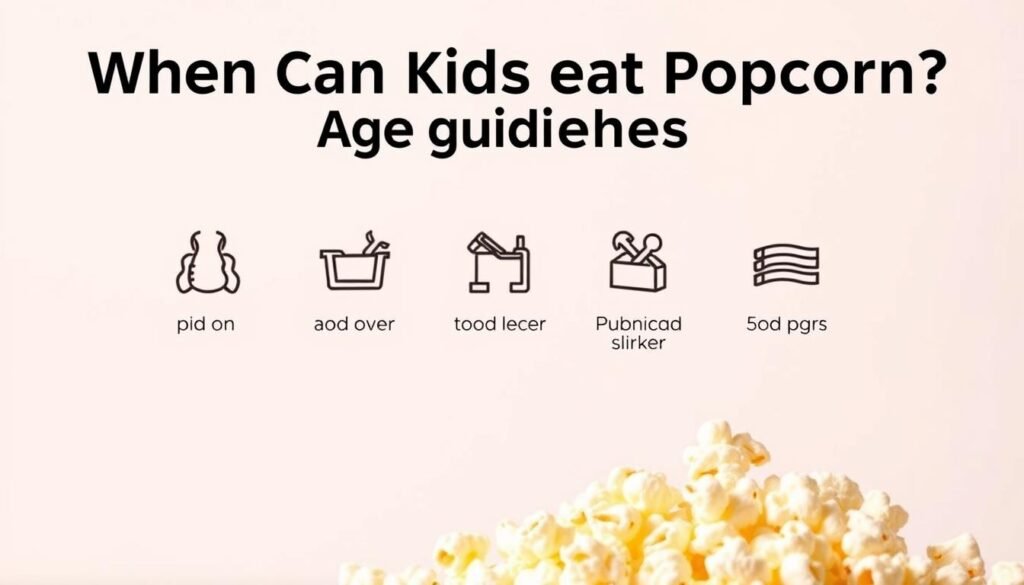Is popcorn a safe snack for your little ones? This question often leaves parents puzzled. While popcorn is a favorite treat for many, it poses hidden risks for young children. Understanding the right age and precautions is essential to ensure their safety.
The American Academy of Pediatrics recommends waiting until children are at least four years old before introducing popcorn. This guideline focuses on both age and developmental readiness. Younger children may not have the chewing and swallowing skills needed to handle this snack safely.
Choking hazards are a primary concern. Popcorn’s hard kernels and fluffy texture can easily block small airways. Parents should also consider alternatives that are safer and equally enjoyable for younger kids.
This article explores safety tips, nutritional benefits, and alternative snacks. By following these guidelines, you can make informed decisions about introducing popcorn to your child’s diet.
Key Takeaways
- Popcorn is not safe for children under four years old.
- The American Academy of Pediatrics emphasizes age and developmental readiness.
- Choking hazards are a significant concern with popcorn.
- Parents should explore safer snack alternatives for younger kids.
- Understanding safety tips can help prevent accidents.
Introduction to Popcorn and Kids
From movie nights to family gatherings, popcorn is a staple snack in many households. Its origins trace back to Indigenous peoples of the Americas, who first cultivated it. European colonization later spread its popularity worldwide, making it a cultural icon.
Popcorn’s appeal lies in its versatility. It’s a whole grain, offering fiber and essential nutrients. This makes it a healthier option compared to many processed snacks. Families often enjoy it during movie nights, creating lasting memories.
However, its crunchy texture poses risks for young children. The hard kernels and fluffy pieces can be choking hazards. Parents must weigh its appeal against safety concerns.
This article aims to balance safety and enjoyment. It explores popcorn’s nutritional benefits, risks, and alternatives. By understanding these factors, families can make informed choices about this beloved snack.
When Can Kids Eat Popcorn? Age Guidelines
Understanding the right age for introducing certain foods is crucial for child safety. Popcorn, while a popular snack, requires careful consideration due to its potential risks. Parents must evaluate both age and developmental readiness before offering it to their child.
Why Popcorn is a Choking Hazard
Popcorn’s texture makes it a significant choking hazard. The hard kernels and fluffy pieces can easily block small airways. This risk is especially high for children under four years old, who may not have fully developed chewing skills.
Even with molars, which typically develop between 24-36 months, young children may struggle to chew popcorn effectively. Parents should always supervise snack time and ensure their child is seated and focused while eating.
Developmental Readiness
Chewing ability is closely linked to molar development. However, having molars does not guarantee a child is ready for popcorn. Coaching is essential to teach safe eating habits. Demonstrate proper chewing techniques and check for unpopped kernels after each bite.
It’s recommended to wait until a child is at least four years old, even if molars are present. Early introduction should be limited to learning sessions rather than regular snacking. This approach minimizes risks while helping children develop the skills needed for safe consumption.
Safety Tips for Serving Popcorn to Kids
Ensuring safety while serving snacks to children is a top priority for parents. Popcorn, while a beloved treat, requires specific precautions to minimize risks. By following these guidelines, families can enjoy this snack without worry.
Supervised Eating
Always supervise children while they enjoy popcorn. This ensures they chew thoroughly and avoid swallowing large pieces. Encourage them to take one piece at a time and exaggerate chewing motions. This step-by-step way of eating reduces choking hazards significantly.
Preparing Popcorn Safely
Choose air-popped popcorn to control the amount of oil and salt. This method is healthier and avoids unnecessary additives. Sift through the popcorn to remove unpopped kernels or stale pieces, which can pose risks.
Opt for hull-less varieties, as they are softer and safer for young children. Be cautious with store-bought brands, as they may contain allergens like dairy or soy. Reading labels carefully ensures a safer snacking experience.
By following these tips, parents can make popcorn a safe and enjoyable treat for their family.
Is Popcorn a Healthy Snack for Kids?
Popcorn is often praised for its nutritional value, but is it a healthy choice for children? The answer depends on how it’s prepared. When made correctly, it can be a wholesome and satisfying option for families.
Nutritional Benefits
Popcorn is a whole grain, packed with fiber and essential nutrients. It’s a healthier alternative to many processed snacks. Homemade air-popped popcorn is the best choice, as it avoids unnecessary additives.
Fiber aids digestion and keeps children feeling full longer. This makes it a smart option for active kids. Plus, it’s low in calories when prepared without excess butter or salt.
Moderation and Preparation
While popcorn has benefits, moderation is key. It should be part of a varied diet, not a daily staple. Avoid microwave popcorn, which often contains high levels of sodium and unhealthy fats.
For flavor, try herbs or nutritional yeast instead of butter. These options add taste without compromising health. Always sift through the popcorn to remove unpopped kernels, ensuring safety.
Store popcorn in an airtight container to maintain freshness and texture. This simple step keeps it ready for a quick and healthy snack anytime.
Popcorn Alternatives for Young Children
Finding safe and enjoyable snacks for young children can be a challenge for parents. While popcorn is off the table for toddlers, there are plenty of nutrient-rich and age-appropriate options to explore.
Soft puffs and rice cakes are excellent choices. These snacks are easy to chew and pose minimal choking risks. Sliced apples or steamed vegetables also make great alternatives, providing essential vitamins and fiber.
For a protein boost, consider edamame or chickpea puffs. These foods are not only safe but also help toddlers develop chewing skills. Avoid hard, round items like whole grapes, which can be hazardous.
Combining textures, such as crackers with guacamole, adds variety and encourages healthy eating habits. These alternatives play a vital role in teaching toddlers how to chew and swallow safely.
By choosing the right snack, parents can ensure their little ones enjoy delicious and safe options while building essential skills.
Conclusion
Deciding the right time to introduce certain snacks requires careful thought and planning. The 4-year guideline serves as a baseline, but it’s not a guarantee. Each child’s maturity and chewing skills should be assessed individually.
Key safety practices include supervision, removing unpopped kernels, and preparing popcorn plain. These steps reduce risk and ensure a safer experience. Parents are right to exercise caution, as it’s better to wait until their child is fully ready.
Until then, exploring alternative snacks is a smart move. Soft, nutrient-rich options can provide similar enjoyment without the hazards. By taking these steps, parents can confidently navigate this stage of their child’s development.
FAQ
Why is popcorn considered a choking hazard for young children?
Popcorn kernels and hard pieces can easily block a child’s airway. Young children lack the molars and chewing skills needed to break it down safely, increasing the risk of choking.
At what age is it safe for children to enjoy popcorn?
The American Academy of Pediatrics recommends waiting until age 4 or older. By this age, most children have developed the necessary chewing and swallowing skills to handle it safely.
How can parents reduce the risk of choking when serving popcorn?
Always supervise children while they eat. Serve air-popped popcorn without added butter or salt, and ensure it’s fully popped to avoid hard kernels.
What are the nutritional benefits of popcorn for kids?
Popcorn is a whole grain snack rich in fiber, making it a healthy option when prepared without excessive butter or salt. It’s a great alternative to processed snacks.
Are there safer snack alternatives for toddlers?
Yes, soft foods like puffed rice, cheese cubes, or small fruit pieces are better options for young children. These minimize choking hazards while providing nutrition.
What signs indicate a child is ready to eat popcorn?
Look for strong chewing skills, the ability to sit still while eating, and the presence of molars. These are key developmental milestones for handling popcorn safely.



